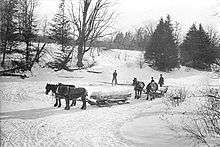Ice cutting
Ice cutting is a winter task of collecting surface ice from lakes and rivers for storage in ice houses and use or sale as a cooling method. Rare today, it was common before the era of widespread mechanical refrigeration and air conditioning technology.[1] The work was done as a winter chore by many farmers and as a winter occupation by icemen. Kept insulated, the ice was preserved for cold food storage during warm weather, either on the farm or for delivery to residential and commercial customers with ice boxes. A large ice trade existed in the 19th and early 20th centuries, until mechanical refrigeration displaced it.
Ice harvesting generally involved waiting until approximately a foot of ice had built up on the water surface in the winter. The ice would then be cut with either a handsaw or a powered saw blade into long continuous strips and then cut into large individual blocks for transport by wagon back to the ice house.[2] Because snow on top of the ice slows freezing, it could be scraped off and piled in windrows. Alternatively, if the temperature is cold enough, a snowy surface could be flooded to produce a thicker layer of ice.[3] A large operation would have a crew of 75 and cut 1500 tons daily.[4] In the 1880s, New York City had over 1500 ice delivery wagons and Americans consumed over 5 million tons of ice annually.[5]
Ice cutting is still in use today for ice and snow sculpture events. A swing saw is used to get ice out of a river for the Harbin International Ice and Snow Sculpture Festival each year. A swing saw is also used to cut ice out from the frozen surface of the Songhua River, China.[6] Many ice sculptures are made from the ice harvested this way. In some countries at high latitudes, even ice hotels and ice palaces are made.
References
- Inspection of Ice. Ice and Refrigeration Illustrated, Southern Ice Exchange. 1896. Retrieved 2011-10-17.
- Jones, J. C. (1984) America's Icemen: An Illustrative History of the United States Natural Ice Industry 1665-1925. Jobeco Books, Humble, Texas. ISBN 978-0-9607572-1-3
- Bowen, John T (1928). "Harvesting and Storing Ice on the Farm". Farmer's Bulletin: 6–8. Retrieved 2014-05-25.
- Ward, Tom (1975). Cowtown : an album of early Calgary. Calgary: City of Calgary Electric System, McClelland and Stewart West. p. 192. ISBN 0-7712-1012-4.
- O'Donnell, Edward T. (31 July 2005). "The Dawn of New York's Ice Age". The New York Times. Retrieved 26 August 2019.
- AFP (13 November 2008). "Ice is money in China's coldest city". The Sydney Morning Herald. Retrieved 26 December 2009.
External links
| Wikimedia Commons has media related to Ice cutting. |
- The Ice Industry, from 1795-1895. One hundred years of American commerce, edited by Chauncey Mitchell Depew
- Maine Ice Industry, an annual report of the Bureau of Industrial and Labor Statistics for the State, by the Maine Bureau of Industrial and Labor Statistics
- Use Your Car for Ice-Cutting This Winter, Popular Science monthly, February 1919, page 34.
- KK.org Amish Homebuilt gas powered ice cutter to make ice for non-electric icebox
- blueflower.tripod.com Homebuilt gas powered ice cutter
- HMdb.org THE HISTORICAL MARKER DATABASE, Ice Harvesting
- winnipeg.ctv.ca Modern ice cutter in Manitoba.
- pudsandlosers.blogspot.com, Ice Palace 2 - Cutting Ice, Saturday, January 31, 2009
